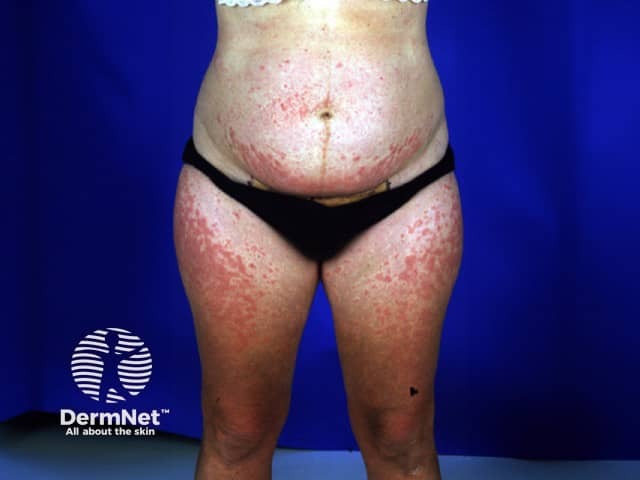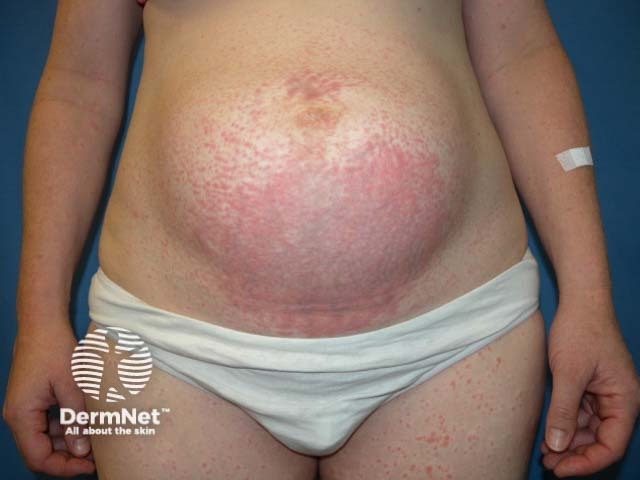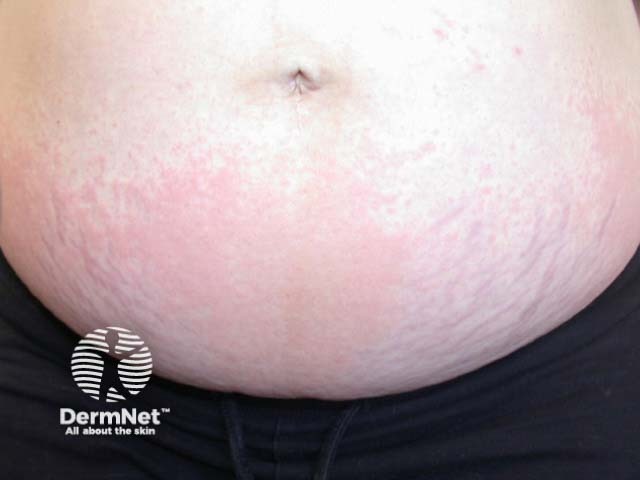Main menu
Common skin conditions

NEWS
Join DermNet PRO
Read more
Quick links
Polymorphic eruption of pregnancy — extra information
Polymorphic eruption of pregnancy
Author: Hon A/Prof Amanda Oakley, Dermatologist, Hamilton, New Zealand, 1999. Updated by Dr Ebtisam Elghblawi, September 2017.
Introduction Demographics Causes Features Diagnosis Differential diagnoses Effect on pregnancy Length of occurence Treatment Recurrence
Introduction
Polymorphic eruption of pregnancy is an itchy, bumpy rash that starts in the stretch marks of the abdomen in the last 3 months of pregnancy then clears with delivery.
It is also called PUPPP or Pruritic Urticarial Papules and Plaques of Pregnancy.

Polymorphic eruption of pregnancy PUPPP


Who gets polymorphic eruption of pregnancy?
Polymorphic eruption of pregnancy occurs in about 1 in 160 pregnancies.
- It is more common in the first pregnancy than subsequent pregnancies.
- It is more commonly reported in women with white skin than in women with black skin.
- The risk is greater with excessive weight gain, including multiple births (eg twins or triplets).
- A male fetus is a greater risk than a female fetus.
What causes polymorphic eruption of pregnancy?
Polymorphic eruption of pregnancy is thought to be related to stretching of the skin on the abdomen. The stretching elicits an immune response due to connective tissue damage. Supporting the stretch mark theory are the following observations:
- Most cases begin in the last 3 months, especially in the last 5 weeks when the stretching is greatest.
- The rash usually starts in the stretch marks around the umbilicus where stretching of the abdomen is greatest.
- Triplet pregnancies have a higher risk (14%) than twin pregnancies (2.9%).
Another theory considers low-level traffic of fetal cells within the mother's circulation, which appears increased in women with polymorphic eruption of pregnancy, and may persist for some time after the baby has been born.
What are the features of polymorphic eruption of pregnancy?
The rash usually begins during the third trimester, in the last few weeks of pregnancy. About 15% of women with polymorphic eruption of pregnancy report that it actually began immediately after delivery.
Small pink papules appear first in the stretch marks around the umbilicus, often with a pale halo around each papule. The papules coalesce to form large, red, urticated (hive-like) plaques, and occasionally small vesicles are present. The rash spreads from the abdomen to involve the buttocks and thighs, and sometimes the arms and legs. Lesions on or above the breasts are rare.
Polymorphic eruption of pregnancy is very itchy (pruritic) and patients find it difficult to sleep at night.
How is polymorphic eruption of pregnancy diagnosed?
The history and clinical findings are usually typical. There are no specific tests. Skin biopsy findings are nonspecific.
What is the differential diagnosis for polymorphic eruption of pregnancy?
Rashes in pregnancy include those that affect non-pregnant women. An itchy rash early in pregnancy is usually caused by prurigo of pregnancy or atopic eczema. When the rash starts in the umbilicus itself or blisters are present, a diagnosis of pemphigoid gestationis may be considered. Skin biopsy is confirmative.
Does polymorphic eruption of pregnancy affect the baby?
Rarely, the baby can be born with a mild form of polymorphic eruption of pregnancy rash but this soon fades. Polymorphic eruption of pregnancy does not cause any other problem for the baby.
How long does polymorphic eruption of pregnancy last?
Polymorphic eruption of pregnancy continues until delivery then usually resolves within 4–6 weeks. Rarely, it may persist for longer. In some cases, this relates to retained placental products.
What is the treatment for polymorphic eruption of pregnancy?
There is no curative treatment for polymorphic eruption of pregnancy (apart from delivery!). Symptoms can be controlled using:
- Emollients (moisturisers) applied liberally and frequently as required.
- Topical steroids applied thinly once or twice daily to the red itchy patches.
- A short course of systemic steroids (eg, prednisone), in severe polymorphic eruption of pregnancy.
- Antihistamines — antihistamine tablets appear safe in late pregnancy (though they may make the baby drowsy on delivery).
Can polymorphic eruption of pregnancy recur with future pregnancies?
It is very uncommon for polymorphic eruption of pregnancy to recur. If it occurs, it is likely to be milder.
References
- Polymorphic Eruption of Pregnancy — Medscape Reference
- Pregnancy-Specific Skin Disorders — Skin Therapy Letter 2014.
On DermNet
Other websites
- Pruritic Urticarial Papules and Plaques of Pregnancy — Medscape Reference
- Polymorphic Eruption of Pregnancy — British Association of Dermatologists
